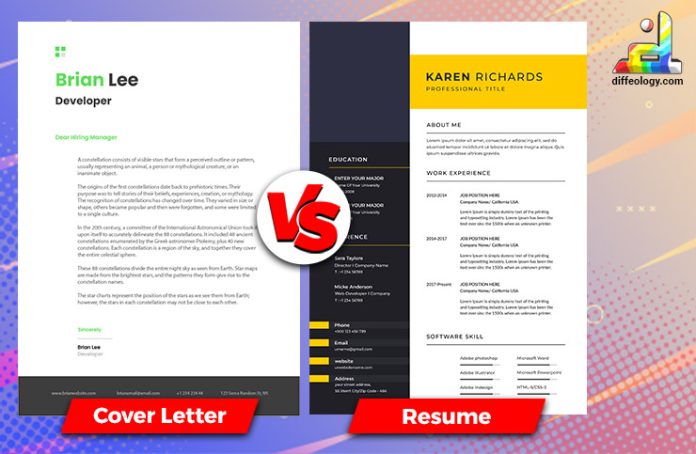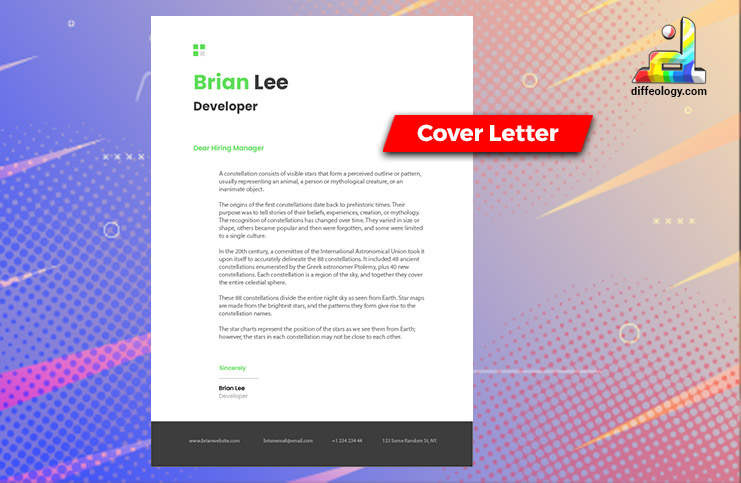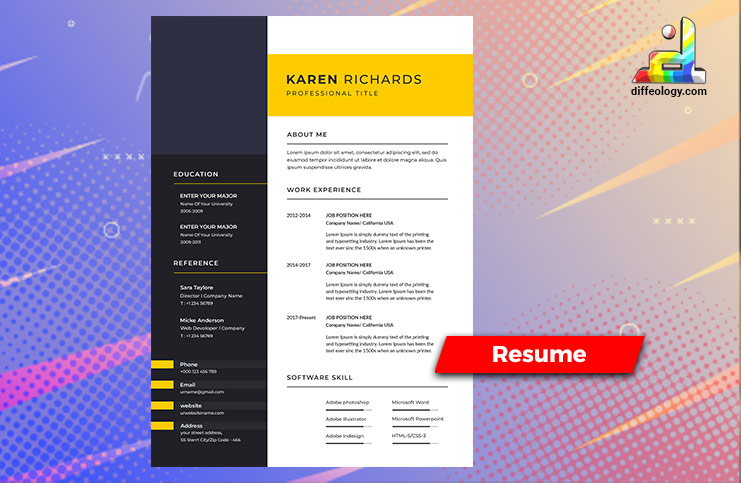There is a huge Difference Between A Cover Letter and A Resume. A cover letter is like a letter that introduces and summarizes your resume or CV before you send it to a potential employer.
Moreover, a curriculum vitae (CV), or simply a CV, serves as a concise summary of your work and educational background. Notably, it’s the initial element that captures an employer’s attention and offers a swift overview of your job history.
In today’s competitive job market, both of these documents are super important. They’re like your first impression of a potential boss. People often mix them up, but they’re quite different. Let’s break down the main differences between a CV and a cover letter in simpler terms.
Main Difference Between A Cover Letter and A Resume
Cover letters are formal greetings or introductions that briefly describe the applicant, his interest in the position, and his qualifications for the job. In the same way, a resume is a synopsis of one’s professional and academic background.
A Cover Letter Vs. A Resume
What is a Cover Letter?
Imagine you’re applying for a job, right? Well, a cover letter is like a friendly introduction to your job application package. It’s the first thing that grabs the employer’s attention. In essence, it’s a written note that accompanies your resume. This note offers you the chance to stand out and make a memorable first impression, just like a firm handshake at an interview.
Moreover, what’s cool about a cover letter is that it’s your opportunity to tell a bit of your story. You can delve into your background, outline your skills, and explain why you’re the perfect fit for the job. It resembles a mini sales pitch where you have the opportunity to discuss your qualifications. Most importantly, it allows you to articulate why you’re enthusiastic about the gig and the company. In essence, it’s all about making a convincing case for why you’re the right person to join their team.
Read Also: Difference Between Font And Typeface
So, to sum it up, a cover letter is that personalized touch in your job application that lets you show off your personality, connect the dots between your experiences and the job, and give employers a glimpse into why you’re excited about the opportunity. It’s your chance to shine, so don’t miss it!
What is a Resume?
Alright, so picture this: a resume is like your professional highlight reel. It’s the go-to document when you’re on the job hunt. In essence, it’s a snapshot of your entire career packed into a neat, concise package. This document lays out the story of your work life – where you’ve been, what you’ve done, and what makes you a top-notch candidate.
Furthermore, what’s crucial about a resume is that it’s your chance to showcase your skills, experience, and accomplishments. It’s your moment to shine and tell employers, ‘Hey, here’s why I’m the person you’ve been looking for.’ Essentially, it’s like presenting your career journey in a structured, easy-to-read format that lets employers quickly see if you’ve got what it takes for the job.
Read Also: Difference Between Book and Novel
So, a resume is your professional calling card. It’s the document that HR pros and hiring managers rely on to get a clear picture of your qualifications and decide if you’re a match for their team. So, when you’re job hunting, remember that your resume is your ticket to the interview and, ultimately, your dream job.
Difference Between A Cover Letter and A Resume in Detail
1. Purpose:
A cover letter is like the sidekick to your resume when you’re applying for a job. It’s there to introduce yourself to the boss, tell them why you’re into the job, and show off your skills and experiences that make you a good fit. It’s like your chance to add a personal touch and explain why you’re a perfect match. Your resume is the star of the show. It’s a one-stop shop for your work history, school stuff, skills, and wins. Instead of talking about why you want the job, it’s all about showcasing your job-related awesomeness in a clear, compact way.
2. Content:
Think of a cover letter as a mini-story. It’s got a hello, an intro, a middle part where you talk about your skills and stuff, and a “catch you later” at the end. Use it to explain why you’re the one for the job and why you’re super into the company. Your resume’s more like a list of categories. It’s got your contact info up top, a summary or job goal thing, a work history section, school stuff, skills, and maybe some extra goodies like awards or certificates. It’s all about giving the facts.
3. Length:
Keep it short and sweet. A cover letter is usually just a couple of paragraphs about the length of a good tweet or two. Your resume’s a bit longer, but don’t go overboard. Most folks keep it to one or two pages unless you’re a big shot with tons of experience.
4. Tone:
You can be a bit more personal in your cover letter. It’s like having a friendly chat with your future boss. Show your excitement and let your personality shine through. For your resume, stick to the facts. It’s more like a business report. Be clear and professional, and save the personality for the cover letter.
5. Formatting:
Make your cover letter look like a letter. Start with your info, then theirs, add a friendly hello and finish with a nice goodbye and your signature. Your resume should be easy to skim. Use headings and bullet points to keep it organized and reader-friendly.
6. Customization:
Each cover letter should be a custom job. Tailor it to the specific job and company you’re applying to. Show them you’ve done your homework. Your resume is more like a template. The basics stay the same, but you can tweak your job goal or add extra skills to match the job you’re gunning for.
7. Primary Focus:
In your cover letter, shine the spotlight on why you’re perfect for this particular job. Tell them how you fit in with their company vibes and what makes you a top choice. Your resume’s all about your past wins. It’s like showing off your report card. HR folks use it to see if you’ve got the skills and experience to rock the job.
8. Narrative vs. Bullet Points:
In a cover letter, it’s like spinning a little tale. You get to connect the dots between your experiences, making it clear why you’re an excellent fit for the job. It’s all about showcasing your communication skills, and, as a result, you can paint a persuasive picture.
Now, when it comes to the resume, it’s all about keeping it short and sweet. Imagine it as a list of your greatest hits. Instead of storytelling, you use bullet points. This helps highlight your skills and achievements in a way that’s quick and easy to skim.
9. Contact Information Placement:
Picture this: your contact info is right up top on the cover letter, followed by the employer’s details. It’s like a friendly introduction, setting the stage for the conversation.
On the resume, your contact info still starts things off, but it’s just your info. This is more about giving the employer an easy way to reach out to you, plain and simple.
10. Personal vs. Professional Summary:
Now, here’s where you can add a personal touch. In your cover letter, you might casually mention why you’re so passionate about the industry or how you stumbled upon the job. It’s the spot to let your personality shine through.
As for the resume, it kicks off with a professional summary or objective statement. This part is all business. It’s where you lay out your skills and career goals without diving into personal stories or motivations.
Comparison Table “Cover Letter Vs. Resume”
| Reasons of Distinctions | Cover Letter | Resume |
|---|---|---|
| Purpose | It’s your intro, shows you’re interested, and talks up your skills. | It’s the facts about your work and school stuff. |
| Content | Think of it like a short story. It’s got a friendly vibe and shows you’re excited. | This is like your info report – formal and straightforward. |
| Length | Keep it short, just a couple of paragraphs, like a tweet or two. | Usually, it’s one or two pages unless you’ve got tons of experience. |
| Tone | Be personal, like talking to a friend. Let your personality shine. | Be all business here, no chit-chat. It’s a report, after all. |
| Formatting | Make it look like a letter. Start with your info, then there’s like an intro to a chat. | Use headings and bullet points to keep it neat and easy to read. |
| Customization | Customize it for each job. Show you did your homework. | Use the same basic template, but tweak it for each job you’re after. |
| Primary Focus | Shine a light on why you’re perfect for this job and how you fit with the company. | It’s all about your past wins – your report card for work. |
| Narrative vs. Bullet Points | In the cover letter, spin a little tale to connect the dots and paint a picture of why you’re a great fit. | On the resume, keep it short and sweet with bullet points. |
| Contact Info Placement | Your info is up top on the cover letter, followed by theirs. It’s a friendly intro like I said. | In the resume, start with your info. It’s just about making it easy to get in touch. |
| Personal vs. Professional Summary | Here, you can add a personal touch. Mention why you’re passionate or how you found the job. | Resumes start with a professional summary. It’s all business – your skills and career goals. |
Key Difference Between A Cover Letter and A Resume
- Purpose: A cover letter, for instance, introduces you and earnestly expresses your enthusiasm for the job. In contrast, a resume serves to provide a detailed overview of your qualifications.
- Content: Cover letters, on the other hand, tell a compelling story, skillfully connecting your background to the job in question. Resumes, meanwhile, succinctly list your impressive achievements and skills.
- Length: While cover letters are typically shorter, usually spanning just a couple of paragraphs, resumes can vary in length but commonly range from 1 to 2 pages.
- Tone: Cover letters maintain a more personalized and conversational tone to engage the reader. Resumes, in contrast, adopt a formal and objective approach.
- Formatting: Cover letters adhere to a traditional letter format, including a friendly greeting and a courteous closing. Resumes, conversely, employ a structured layout with sections and bullet points to ensure clarity.
- Customization: For cover letters, it’s essential to remember that they should be meticulously customized for each job application, reflecting your genuine interest. Resumes, while maintaining a consistent structure, allow for some level of tailoring to suit specific roles.
- Primary Focus: Cover letters, without a doubt, zero in on explaining precisely why you’re a stellar fit for the specific job and company at hand. In contrast, resumes place the spotlight firmly on your qualifications and showcase past accomplishments.
FAQs:
Conclusion
Job applicants often include a cover letter with their resume to describe their interest in and suitability for the position, as well as to highlight their relevant skills and experience. This means that although a cover letter might be more personal, a resume focuses on the facts. In this respect, a cover letter differs significantly from a résumé. So, here is the Difference Between A Cover Letter and A Resume.
References & External Links
- How To Write a Cover Letter (With Examples and Tips)
- Easily create standout resumes



